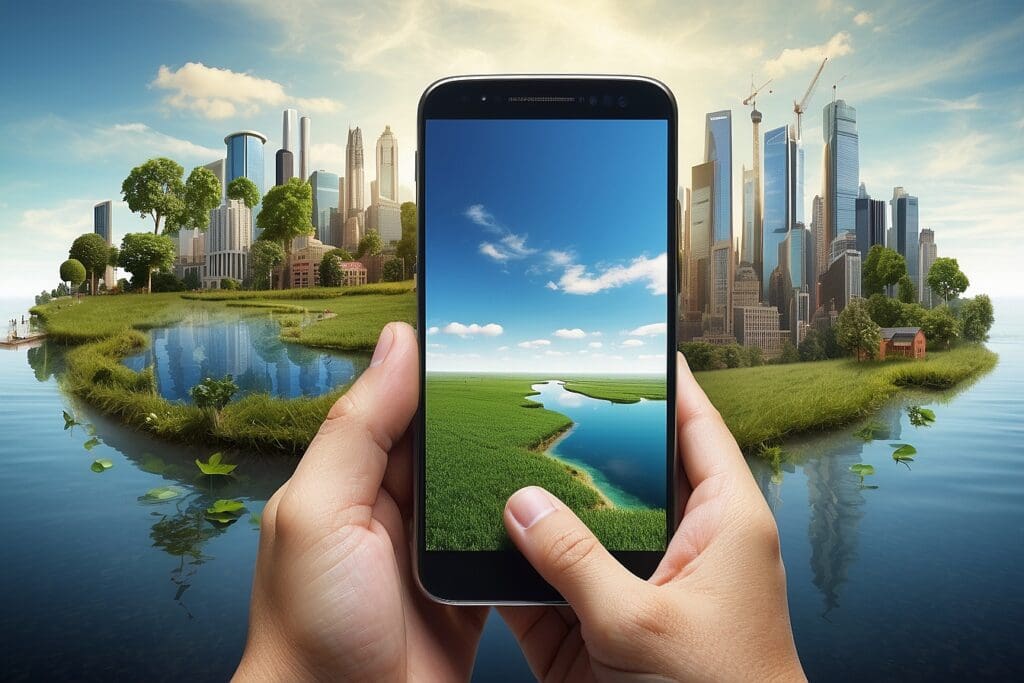We use high tech gadgets like cell phones all day, every day, but we almost never stop to ask questions about their environmental impact. For instance: Where do cell phones come from? What happens to all of the cell phones that we simply stop using when we move on to the next latest and greatest device? How much power does it take to keep all the cell phones of the world running? Cell phones are one of the leading contributors to the e-waste crisis we are currently dealing with as a planet.
Lifecycle of the Average Cell Phone
In order to make a cell phone there are several things that must happen, and there are environmental impacts associated with each step of the process.
Extraction and Processing
First, raw materials must be extracted from the earth and processed before they go to factories where the phones are constructed. This task depletes natural resources like crude oil, copper, gold, palladium, and silicon. It also requires considerable amounts of energy and water, and generates pollution and waste. Consider just one example—it is estimated that over 220 pounds of mine waste is generated to extract the gold for a circuit board of just one cell phone.2
Component Manufacturing
Over half of a phone’s negative environmental impacts occur during the manufacturing process. Each phone consists of 500 to 1,000 components that must be shaped and fitted together in polluting factories (most are currently located in China).3 In one assessment, a group of Swiss researchers found that 40-50% of the environmental impacts over the entire life of a cell phone occur during the single process of manufacturing printed wiring boards and integrated circuits.4,5
Another negative outcome that occurs during the manufacturing process is the exposure of workers to toxic metals and chemicals. Toxic materials like lead, cadmium, mercury, and poly vinyl chlorides (PVCs) are common in cell phones. And although the European Union began enforcing stricter toxic metal and chemical standards in 2006, these materials are still prevalent in black market cell phones, and often make their way to open air dumps in South America.7
Transportation
Transportation first to manufacturing plants, and then to distributers and customers generates more negative impacts on the environment due to the burning of fossil fuels.
Installation and Use

During the cell phone’s use, its environmental impact results from the electricity generated to power wireless infrastructure and charge our phones. In just one year, it is estimated that one cell phone uses the energy equivalent to 32 gallons of gas, and emits 112 kilograms of carbon dioxide (CO2).8 Modern cell phone chargers can draw about half a watt of power, even when there is no cell phone connected to them.9
Incineration, Landfilling, or Recycling
In the United States the average consumer keeps their phone for less than one year before getting a new one. When they replace it, they decide whether to recycle it or send it to a landfill or incinerator where toxic substances can get into the soil, water and air. Every year, 140,000,000 cell phones (that’s 4 per second!) will make their way into a landfill, where they will collectively leach 80,000 pounds of lead into the earth and groundwater supply of surrounding communities.10
The graphic above displays the recycling rates of cell phones and other common electronics in the US. Based on the fact that only 10% of the cell phones in the US are recycled, it is not surprising that the single best thing you can do to reduce the environmental impact of your cell phone is to recycle it. Extending the service life of your phone from one to four years decreases your environmental impact by about 40% and also limits the number of resources that must be mined to make new phones.12 You can also donate your used cell phones to charities that will put them to really good use! Here are some resources to get you started:
http://www.phones4 charity.org/
http://cellphonesforsoldiers.com/
http://shelteralliance.net/recycle-cell-phones-to-benefit-domestic-violence-shelters
Environmental and Health Effects of Cell Phone Radiation
In addition to the negative impacts that occur throughout the lifecycle of a cell phone, it is also important ask ourselves: What are the negative environmental health effects borne from holding “tiny, low-power microwave ovens, without walls” against the sides of our heads?13 In the most ambitious study of its kind seeking to answer this question, scientists from 13 different countries ran a long-term study to determine whether there was any link between cell phone use and cancer. The results were inconclusive—as the head of the Radiation Group put it, “we have not demonstrated conclusively that there’s a risk…but I think it’s really important to note that that does not mean that there’s no risk.” The study yielded many strange results. For example, some people who never or very rarely used cell phones seemed to have a higher tumor risk than moderate users. However, the study also indicated that there is a significantly higher risk (about 40% higher) of deadly gliomas brain tumors and salivary gland tumors –specifically on the side of the head where they use their phone—among people who have used cell phones for 10 years or longer.14
It was this troubling finding that led journalist Christopher Ketcham to do an investigative piece on the dangers of cell phones for GQ magazine.15 As Ketcham examined the history of cell phone health studies in the United States, he discovered that it was hard to talk about the dangers of cell phone radiation without sounding like a conspiracy theorist. Non-industry-funded studies are rare in the United States, legislation protects the wireless industry from legal challenges, and our lives have been so thoroughly integrated with wireless technology that it seems crazy to think they might be doing us harm.16 Ketcham pointed out that if we ignore the health studies funded by the telecom or cell phone industry, 75 percent of studies have found that cell phones, cell towers, and Wi-fi networks are biologically harmful and may lead to a range of health issues including “brain aging,” brain damage, early-onset Alz¬heimer’s, senility, DNA damage, and sperm die-offs.17
Radiation given off by mobile phones and other high-tech gadgets is also suspected to cause problems for creatures who can’t vocalize dissent. Cell phones are one possible reason for the recent increase in the occurrence of bee colony collapse disorder. The theory is that radiation from cell phones interfere with bee’s navigation systems, and thus prevent them from returning to the hive.18 If you are interested in finding out more about saving the honey bees, read up here!
If you are as attached to your cell phone as I am to mine, the information presented here about the impacts of cell phones on the environment and your health is likely to make you feel crummy, but it probably won’t make you lose the cell phone and go back to the age of landlines. One thing you can do to protect yourself, though, is strive to be a smart consumer. Check out this user-friendly guide to cell-phone radiation emissions. It ranks over 1,000 phones that are currently on the market.19 And remember, when you go to get a new low-emission phone, be sure to donate or recycle your old one!





